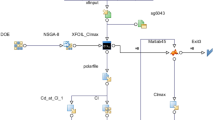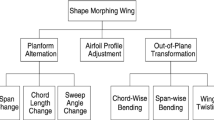Abstract
Airplanes stay lifted into the air due to the pressure difference exerted on their wings. Wings of aircraft are designed to generate lift by directing airflow such that it accelerates over the top and presses down more intensely on the underside. Although there exists a substantial body of literature that delves into the significance of airfoil design for improving aerodynamic efficiency, there is a conspicuous dearth of research pertaining to the development of a new airfoil derived from the NACA 23012 aerofoil. To bridge this critical gap in the current body of knowledge, this investigation aims to introduce innovation by crafting an original airfoil, building upon the foundational principles of the NACA 23012 aerofoil. The high-fidelity panel method was used to investigate an operating range of high Reynolds number, Re = 2 × 106. Many reconfigured airfoils have been designed and analyzed using a parametric study in XFLR5. The numerical setup's validity is established through a comparative analysis with Miley's experimental findings, revealing that the setup exhibits errors of less than 4% across all tested cases. Additionally, in a panel dependency test, the setup demonstrates minimal variation, with discrepancies remaining under 1%. To improve the aerodynamic performance of the new airfoils, geometrical parameters, such as, the leading-edge radius, trailing-edge radius, maximum thickness, and maximum chamber of the NACA 23012 were modified. After analyzing multiple cases, the optimum results for each geometric parameter are combined to generate three new airfoils. The final airfoil with the highest lift-to-drag ratio is further analyzed using flaps. The results show that the new airfoil exhibits a 7% higher lift, 5.2% higher sliding ratio than the base foil, and a 46% lower coefficient of moment than the base foil. An analysis performed on a 3D wing constructed with the new airfoil shows its applicability in constructing a light aircraft. This study contributes to providing a proper overview of effective airfoil design and outlines the necessary short procedures.













Similar content being viewed by others

Abbreviations
- C d :
-
Coefficient of drag
- C l :
-
Coefficient of lift
- C m :
-
Coefficient of moment
- C l /C d :
-
Lift to drag ratio
- Re:
-
Reynolds number
- N :
-
Number of panels
- S i :
-
Source strengths
- K i :
-
Doublet strengths
- n i :
-
Normal vector to the i-th panel
- ds :
-
Differential arc length along the panel
- α :
-
Angle of attack
- Ф :
-
Velocity potential
- ∇ :
-
Laplacian operator
- NACA:
-
National Advisory Committee for Aeronautics
- CFD:
-
Computational Fluid Dynamics
- VAWT:
-
Vertical Axis Wind Turbine
- BEM:
-
Blade Element Momentum
- UAV:
-
Unmanned Aerial Vehicle
- GIT:
-
Grid Independence Test
- LR:
-
Leading-edge Radius
- TR:
-
Tailing-edge Thickness
- MC:
-
Maximum Camber
- MT:
-
Maximum Thickness
References
Eguea, J.P.; Pereira Gouveia da Silva, G.; Martini Catalano, F.: Fuel efficiency improvement on a business jet using a camber morphing winglet concept. Aerosp. Sci. Technol. 96, 105542. https://doi.org/10.1016/j.ast.2019.105542 (2020)
Popov, V.; Loginov, V.; Shmyrov, V.; Ukrainets, Y.; Steshenko, P.; Hlushchenko, P.: Improving aircraft fuel efficiency by using the adaptive wing and winglets. Eastern-Eur. J. Enterp. Technol. 2(1–104), 51–59 (2020). https://doi.org/10.15587/1729-4061.2020.200664
Okamoto, M.; Azuma, A.: Aerodynamic characteristics at low reynolds numbers for wings of various planforms. AIAA J. 49(6), 1135–1150 (2011). https://doi.org/10.2514/1.J050071
Jacobs, E.; Ward, K.; Pinkerton, R.: The characteristics of 78 related airfoil sections from tests in the variable-density wind tunnel. In: National Advisory Committee for Aeronautics, pp. 299–354 (1933)
Cavanaugh, M.A.; Robertson, P.; Mason, W.H.: Wind tunnel test of gurney flaps and T-strips on an NACA 23012 wing. In: 25th AIAA Applied Aerodynamics Conference, vol. 2, no. June, pp. 1060–1077, https://doi.org/10.2514/6.2007-4175 (2007)
Ahmed, N.A.: Demonstration of the effectiveness and limitations of thin airfoil theory in the aerodynamic study of airfoil characteristics. Int. J. Mech. Eng. Educ. 32(4), 271–282 (2015). https://doi.org/10.7227/IJMEE.32.4.1
Hussein, E.Q.; Azziz, H.N.; Rashid, F.L.: Aerodynamic study of slotted flap for Naca 24012 airfoil by dynamic mesh techniques and visualization flow. J. Therm. Eng. 7(2), 230–239 (2021). https://doi.org/10.18186/THERMAL.871989
Todorov, M.: Aerodynamic characteristics of airfoil with single plain flap for light airplane wing. In: ICMT 2015—International Conference on Military Technologies 2015, pp. 1–6, https://doi.org/10.1109/MILTECHS.2015.7153648 (2015)
Khormi, H.; Alfifi, S.: Multi-element airfoil analysis for NACA 0012 using computational fluid dynamics. In: AIAA 2022–1528, https://doi.org/10.2514/6.2022-1528 (2022)
de Paula, A.A.; Kleine, V.G.; Porto, F.D.M.: The thickness effects on symmetrical airfoil flow characteristics at low Reynolds number. In: AIAA SciTech Forum—55th AIAA Aerospace Sciences Meeting, no. January, doi: https://doi.org/10.2514/6.2017-1422 (2017)
Baker, J.R.: Features to aid or enable self starting of fixed pitch low solidity vertical axis wind turbines. J. Wind Eng. Ind. Aerodyn. 15(1–3), 369–380 (1983). https://doi.org/10.1016/0167-6105(83)90206-4
Fupeng, H.; Yuhong, L.; Zuoyi, C.: Suggestions for improving wind turbines blade characteristics. Wind Eng. 25(2), 105–113 (2001). https://doi.org/10.1260/0309524011495908
Paraschivoiu, I.: Wind Turbine Design : With Emphasis on Darrieus Concept. Polytechnic International Press, Montreal (2002)
Marten, D.; Pechlivanoglou, G.; Nayeri, C.N.; Paschereit, C.O.: Integration of a WT blade design tool in XFOIL/XFLR5. In: Proceedings of the DEWEK, no. November, pp. 1–4, [Online]. Available: https://www.researchgate.net/publication/275638785 (2010)
Güzelbey, İH.; Eraslan, Y.; Doğru, M.H.: Numerical investigation of different airfoils at low Reynolds number in terms of aerodynamic performance of sailplanes by using XFLR5. Karadeniz Fen Bilim. Derg. 8(1), 47–65 (2018). https://doi.org/10.31466/kfbd.423932
Vinay Sandapeta, S.; Kiran Parre, S.; Dedeepya, Y.; Jaffar al Aidroos, H.; Vamshi Krishna Reddy, M.: Design and analysis of flying wing UAV using XFLR5. Int. J. Adv. Mech. Aeronaut. Eng., 6(1) (2019)
Millard, J.; Rawther, C.; Booth, S.; Hayashibara, S.: Xflr5 as a design tool in remotely controlled design-build-fly applications. In: AIAA Science and Technology Forum and Exposition, AIAA SciTech Forum 2022, https://doi.org/10.2514/6.2022-0003 (2022)
Anderson, J.; Bowden, M.: Introduction to Flight, 9th ed. McGraw Hill (2022)
Wang, Y.; Zheng, X.; Hu, R.; Wang, P.: Effects of leading edge defect on the aerodynamic and flow characteristics of an S809 airfoil. PLoS ONE 11(9), e0163443 (2016). https://doi.org/10.1371/JOURNAL.PONE.0163443
Hongpeng, L.; Yu, W.; Rujing, Y.; Peng, X.; Qing, W.: Influence of the modification of asymmetric trailing-edge thickness on the aerodynamic performance of a wind turbine airfoil. Renew. Energy 147, 1623–1631 (2020). https://doi.org/10.1016/J.RENENE.2019.09.073
Arra, A.; Anekar, N.; Nimbalkar, S.: Aerodynamic effects of leading edge (LE) slats and slotted trailing edge (TE) flaps on NACA-2412 airfoil in prospect of optimization. Mater. Today Proc. 44, 587–595 (2021). https://doi.org/10.1016/J.MATPR.2020.10.355
Lu, W.; Tian, Y.; Liu, P.: Aerodynamic optimization and mechanism design of flexible variable camber trailing-edge flap. Chin. J. Aeronaut. 30(3), 988–1003 (2017). https://doi.org/10.1016/J.CJA.2017.03.003
Liu, Y., et al.: Influence of the camber trailing-edge wings on the motion performance of underwater gliders. Int. J. Nav. Archit. Ocean Eng. 14, 100468 (2022). https://doi.org/10.1016/J.IJNAOE.2022.100468
Bao, N.; Peng, Y.; Feng, H.; Yang, C.: Multi-objective aerodynamic optimization design of variable camber leading and trailing edge of airfoil. 236(9), pp. 4748–4765. https://doi.org/10.1177/09544062211056012 (2021)
Pei, Z.; Xu, H.-Y.; Deng, L.; Li, L.-X.: Influence of the blunt trailing-edge thickness on the aerodynamic characteristics of the very thick airfoil. Wind, 3(4), 439–458, pp. 439–458. https://doi.org/10.3390/WIND3040025 (2023)
Abbott, I.H., Von Doenhoff, A.E.: Theory of Wing Sections, no. 3. New York: Dover Publications, Inc. (1959)
Leishman, J.G.: Dynamic stall experiments on the NACA 23012 aerofoil. Exp. Fluids 9(1–2), 49–58 (1990). https://doi.org/10.1007/BF00575335
Lednicer, D.: The Incomplete guide to airfoil usage. UIUC Aipplied Aerodynamics Group. https://m-selig.ae.illinois.edu/ads/aircraft.html (2010)
Drela, M.: XFOIL: an analysis and design system for low Reynolds number airfoils. In: Low Reynolds Number Aerodynamics. Springer, p. 12, [Online]. Available: https://doi.org/10.1007/978-3-642-84010-4_1 (1989)
Van Ingen, J.L.: The eN method for transition prediction. Historical review of work at TU Delft. In: 38th Fluid Dynamics Conference and Exhibit, no. June, pp. 1–49, https://doi.org/10.2514/6.2008-3830 (2008)
Katz, J.; Plotkin, A.: Low-Speed Aerodynamics (2001)
Miley, S.J.: A Catalog of Low Reynolds Number Airfoil Data for Wind Turbine Applications (1982)
Reiswich, A.; Finster, M.; Heinrich, M.; Schwarze, R.: Effect of flexible flaps on lift and drag of laminar profile flow. Energies 13(5), 1–17 (2020). https://doi.org/10.3390/en13051077
Tritton, D.J.: Physical Fluid Dynamics. Springer, Dordrecht, p. 362, https://doi.org/10.1007/978-94-009-9992-3 (1977)
Author information
Authors and Affiliations
Corresponding author
Rights and permissions
Springer Nature or its licensor (e.g. a society or other partner) holds exclusive rights to this article under a publishing agreement with the author(s) or other rightsholder(s); author self-archiving of the accepted manuscript version of this article is solely governed by the terms of such publishing agreement and applicable law.
About this article
Cite this article
Akter, F., Hoque, M.A., Ekram, K.A. et al. Design of a Novel Aerofoil of a Light Aircraft for Robust Aerodynamic Performance at High Reynolds Number Regime Using XFLR5. Arab J Sci Eng (2024). https://doi.org/10.1007/s13369-024-08837-6
Received:
Accepted:
Published:
DOI: https://doi.org/10.1007/s13369-024-08837-6



